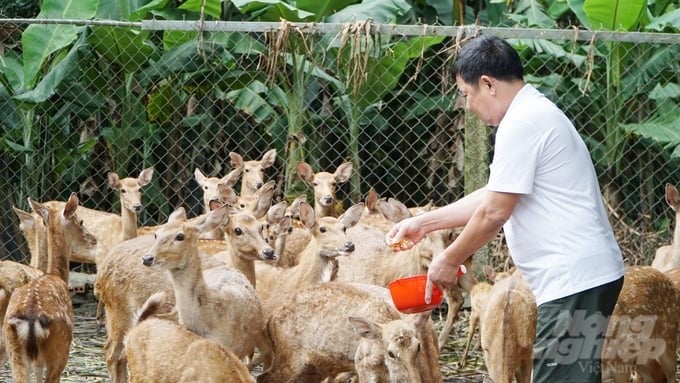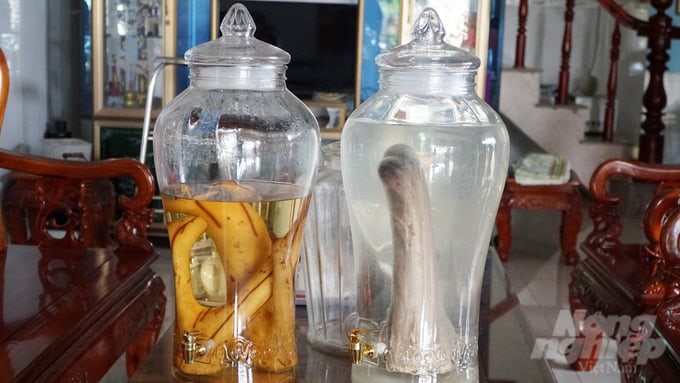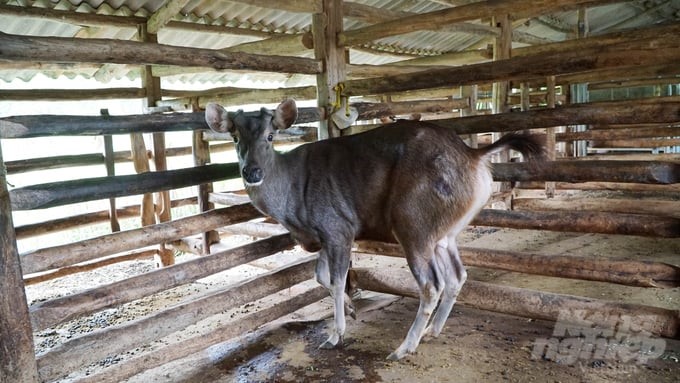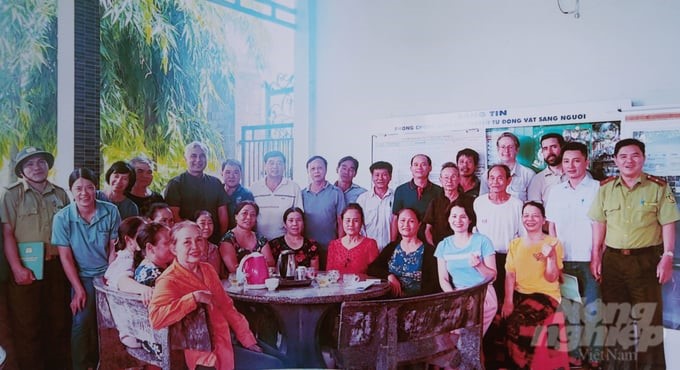May 30, 2025 | 11:43 GMT +7
May 30, 2025 | 11:43 GMT +7
Hotline: 0913.378.918
May 30, 2025 | 11:43 GMT +7
Hotline: 0913.378.918

Hieu Liem commune currently has 125 deer and sambar farming households, with a total herd of up to over 1,000 heads, helping to bring high economic efficiency to farmers. Photo: Le Binh.
Nestled on the bed of Tri An hydropower reservoir, Hieu Liem commune is known as Dong Nai’s "capital" for raising deer and sambar for antlers. Thanks to little care and high economic efficiency, Hieu Liem deer and sambar farming village has helped many families become well off. With over 26 years of experience raising deer and sambar, Mr. Phan Xuan Ngoc's family (hamlet 3, Hieu Liem commune) is one of the households that clearly demonstrates the effectiveness of raising these specialty animals.
Since 1997, Mr. Ngoc has left the land of Huong Son (Ha Tinh province) with a few deer breeds to go to Hieu Liem commune to start up. Realizing that this livestock takes little care and brings economic efficiency, Mr. Ngoc decided to continue raising deer and sambar on the new land.

Deer and sambar antlers have high nutritional and economic value, and many people are willing to pay to use them. Photo: Le Binh.
Currently, the price of sambar antlers is about VND 8 million/kg, while deer antlers cost about VND 25 million/kg. With 40 deer and 10 sambars, after deducting all expenses, each year Mr. Ngoc earns a profit of more than VND 500 million from selling antlers.
“Deer and sambar eat grass and agricultural waste and by-products, so they spend almost no money on feed. Besides, as wildlife, deer and sambar are quite disease-free compared to other livestock. Therefore, raising these animals makes us feel very secure about care and output," Mr. Ngoc shared.
Mr. Thai Van Duong, Vice Chairman of the Hieu Liem Commune People's Committee, said that the commune currently has 125 deer and sambar farming households with a total herd of over 1,000 heads. This is a famous traditional craft village in Vinh Cuu district, specializing in raising deer and sambar for antlers.
“Previously, in Hieu Liem commune, there were many households raising 1-2 deer and sambars. However, these households have linked with each other or invested to increase the total herd to 20–40 heads. Compared to Dong Nai's traditional livestock, raising deer and sambar for antlers has an extremely high and stable economic value," said Mr. Thai Van Duong.

Thanks to deer and sambar farming for antlers, each household earns several hundred million each year. Photo: Le Binh.
In order to meet the needs of developing the craft village and consuming the locality’s traditional products, Hieu Liem Deer Farming Support Services Cooperative was born. Currently, the cooperative has 7 members of the Board of Directors and 23 cooperative members, all of whom are large deer and sambar farming households in the commune.
According to Mr. Nguyen Van Truyen, thanks to sharing from the Commune Farmers Association and cooperative, many households have been helped and shared experiences, capital, and farming techniques. Many high-value deer and sambar antler products were born, meeting domestic consumption demand.
“We are currently completing procedures to register Hieu Liem deer and sambar antlers to become a local OCOP product. This will be an important step in promoting deer antler products to more people. We are also experimenting with atomizing antlers and packaging them into small packages for tourists. This will be more convenient and suitable for more objects," Mr. Nguyen Van Truyen shared.
Currently, 100% of deer and sambar in Hieu Liem commune are issued "birth certificates" by forest rangers and veterinarians, have clear origins, and are carefully controlled. This is also the magnetic needle that Hieu Liem Deer Farming Support Services Cooperative has implemented for many years for sustainable farming.
Besides, in order for the craft village to be sustainable and suitable for environmental requirements, deer and sambar farms in Hieu Liem all apply indigenous microorganism (IMO) technology using available natural raw materials in the locality.
“The cooperative aims for safe and disease-free livestock farming. We are also conscious of protecting the environment and wish to turn the barns into experiential tourist attractions, so the issue of biosafety must be given top priority," Mr. Nguyen Van Truyen added.
Not only does it bring economic efficiency to each farming household, but the deer and sambar farming craft village is making an important contribution to local economic development in general. Since 2017, Hieu Liem commune has had no poor households, and the commune’s per capita income has reached VND 65 million/year.
“For large farming households with 40–50 heads, the income ranges from VND 500 million to nearly VND 1 billion/year. We hope to receive more technical support from the agriculture sector of Dong Nai province as well as expand output so that craft villagers can feel secure enough to develop," shared the Vice Chairman of the Hieu Liem Commune People's Committee.

For sustainable development, Hieu Liem Deer Farming Support Services Cooperative regularly welcomes veterinary officers, forest rangers, and foreign organizations to train and share farming experiences.
With the advantage of being close to tourist attractions such as Dong Nai Culture and Nature Reserve, O-Dong Truong Island, Tri An Lake, etc., connecting tours to visit tourist destinations associated with the Hieu Liem deer and sambar farming craft village is very convenient. Accordingly, tourists can visit deer and sambar farms, learn how to care for and harvest deer and sambar antler products, and buy this specialty.
Translated by Huyen Vu Thu

(VAN) FAO’s Director-General addresses the 5th Baghdad International Water Conference.
/2025/05/26/1716-4-nongnghiep-191706.jpg)
(VAN) Chain linkages, technological innovation, and raw material zoning are three strategic pillars for the coconut industry to strongly develop and elevate its position on the global agricultural map.
![Advanced mariculture – an inevitable trend: [4] Accompanied by scientists](https://t.ex-cdn.com/nongnghiepmoitruong.vn/608w/files/sohk/2025/05/13/1941-pgsts-vo-van-nha-140958_717.jpg)
(VAN) According to Assoc. Prof. Dr. Vo Van Nha, Director of the RIA III, the development of advanced offshore mariculture is no longer an option but an essential path for Vietnam’s fisheries sector.

(VAN) Vietnam is intensifying the development of mollusk farming areas that meet international standards, aiming for sustainable growth and enhancing its export position in the global seafood market.
![Advanced mariculture – an inevitable trend: [3] Policy-driven momentum](https://t.ex-cdn.com/nongnghiepmoitruong.vn/608w/files/doanhtq/2025/05/21/0104-0616-0348-nuoi-bien-170339_789.jpg)
(VAN) To ensure the success of offshore mariculture that uses advanced technologies, it is essential to establish supportive policies that inspire both individuals and enterprises to invest with confidence.
![Advanced mariculture – an inevitable trend: [2] Outstanding results](https://t.ex-cdn.com/nongnghiepmoitruong.vn/608w/files/sohk/2025/05/12/4632-4136-nuoi-bien-11-164117_819.jpg)
(VAN) Pilot models of high-tech offshore mariculture in Vietnam, particularly in the South Central Coast region, have demonstrated exceptional economic returns and sustainability, setting a new direction for the country’s aquaculture industry.
![Advanced mariculture – an inevitable trend: [1] Moving offshore](https://t.ex-cdn.com/nongnghiepmoitruong.vn/608w/files/phucpm/2025/05/18/0252-2436-nuoi-bien-6-162148_783.jpg)
(VAN) Mariculture using advanced technology and moving offshore is an inevitable trend, as nearshore areas increasingly reveal limitations.